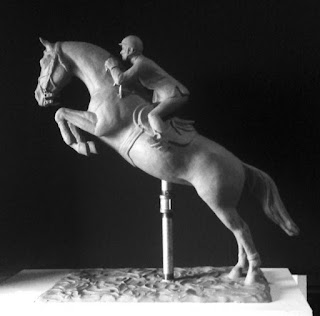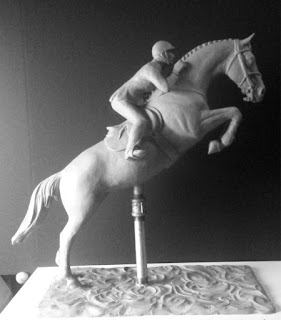After the molds are peeled off of the clay sculpture, heated wax is poured into the sections of the mold and then cooled. This creates a wax that is about 1/4 inch thick or less and is identical to that section of the outer surface of the sculpture. These wax panels are attached to wax sprews and gates which are essentially rods of wax which will become large straws through which the molten bronze metal will travel to fill up the panel. Each panel is only 16 to 20 inches square in order to allow for the foundry workers to be able to move and work with them through the casting process.
The wax sprews are then attached to a wax cup which will become a place to pour the bronze metal into. Next the wax panels are dipped in a slurry of liquid ceramic and coated with very fine sand. this sand is capable of picking up very fine detail, even the fingerprints left on the clay.
After the ceramic coating has dried completely the panel is again dipped in the slurry and coated with more sand. This process is repeated again and again, moving to coarser sand as the layers are created. Eventually, over the course of many days a rock-like or ceramic shell is formed around the wax panel. When the shell is thick enough and dry enough, it is loaded into a burn out furnace which will flash melt the wax out of the shell and heat the shell for casting.
Above, foundry workers are loading the burn out furnace. It will heat the ceramic shells to about 1700 degrees. At the same time bronze ingots are being melted to liquid in a crucible which also is heated to about 1700 degrees.
The heated ceramic shells are then removed from the furnace and molten bronze metal is poured in through the cup at the top of the shell.
When the bronze has cooled enough, the ceramic shell is broken and cleaned off of the surface of the bronze casting. In the case of a large bronze, the panels are like 3 dimensional puzzle pieces which must then be welded back together to create a hollow bronze version of the clay sculpture created by the sculptor.
Above we can see the partially assembled bronze horse with George Washington.
The shiny areas show us where the edges of the panels were welded together and then the welds were ground down and hand textured to match the texture of the sculpture.
 |
| Sandblasting the completed bronze horse sculpture of George Washington. |
The complete bronze sculpture is sandblasted to create and even finish over the entire surface. Patina will then be applied to the surface using heat and chemical reactions on the metal to color the bronze. The surface will then be either laquered and when dry, waxed or else it will be heated and hot wax will be applied to seal the surface of the bronze. When the bronze metal is heated it draws the wax into the pores of the metal, creating a finish which will protect the bronze from the elements.
Cleaning and re applying wax at least yearly is recommended for all outdoor bronze sculptures to maintain the integrity of the finish.
Come to my website
www.corpany.com to see more of my bronze horse sculptures.
Until next time, Kim Corpany.
































